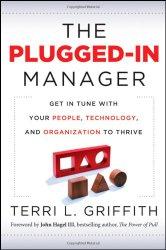WHAT DOES PLUGGED-IN MEAN? COMPUTERS IN CLASS & CONFERENCE ROOMS
/What Does Plugged-In Mean? Computers In Class & Conference Rooms
A colleague recently shared this Washington Post article with me: This year, I resolve to ban laptops from my classroom. Yes, I have seen the studies about long-hand versus typed notes (long-hand wins). But that is comparing across one dimension -- something everyone in any of my classes or workshops knows is not what you want to do.
Your learning experience or meeting is not about lecture and taking a test... or at least it shouldn't be. It should be about the full process: The best course design or collaboration using the best tools (electronic or not), designed to work in the best way with your own skills, context, and needs.
Mixing Human, Technical, and Organizational Dimensions in Your Work
Being plugged-in is about the mix of human, technical, and organizational dimensions. If all we did were listen to lectures, take notes, and then take tests, I might suggest you keep the computer in your bag. If you simply don't have the self-control to stay off of your social streams, then too, maybe leave the computer in the bag until we need it for a specific task.
But, if the computer is giving you a way to link what we're doing in class or in a meeting to how it's going to help you at work, or how it relates to other material -- or if it's the way you're co-creating the learning experience or work product -- then I'm going to ask you to have an "internet enabled device" as part of your toolkit.
Learning By Integrating
I'm just back from a conference where a colleague said he'd banned computers in the classroom. I said I'd have to drop his course. My notes, even those from that conference, are a combination of what's being said plus links back to other material. I think I even sent follow-up emails to colleagues not at the conference so we could take a related action. I'm fully engaged, both with the inflow of the information in the room, but perhaps more importantly, with how that information relates to my own work. Yes, I could create those links after the class or conference session, but few of us get the chance for that kind of reflection. I'll also admit that I may have missed a talking point while integrating a previous point with a possible action item. (Might a different session design have pauses built in to allow for this integration?)
I'm also at a loss when a meeting kicks off with a request to close the laptops or put down the tablets. There is a presumption that all the information we'll need to do our work is in our heads, that we don't have the self-control to stay focused on the topic, and/or that we couldn't be leveraging our tools to do the work of the meeting (taking group notes, getting information from others not present, starting the draft of the report while we can all be looking at the result, etc.) Rarely can I as a meeting leader guess at the best way for the session to go. I need to be confident that my colleagues are making good choices - and of course I want to provide a clear agenda in advance so they can.
The Answer
Plugged-In doesn't mean always connected. It means engaging appropriately with all the human, technical, and organizational dimensions of your work and learning.
- Stop and consider the context and goals of the session, both for you and your colleagues.
- Build your approach to match these goals. Think of it as as negotiating change, even if it's just for yourself.
- Share (think out loud) with your colleagues and look for improvements to your practice. They'll appreciate you're aware of the issues and you may co-create a better overall approach for reaching your goals.
And if you are checking Facebook rather than engaging with your colleagues, realize that the camera documenting the course or meeting, is also pointed right at your screen....








